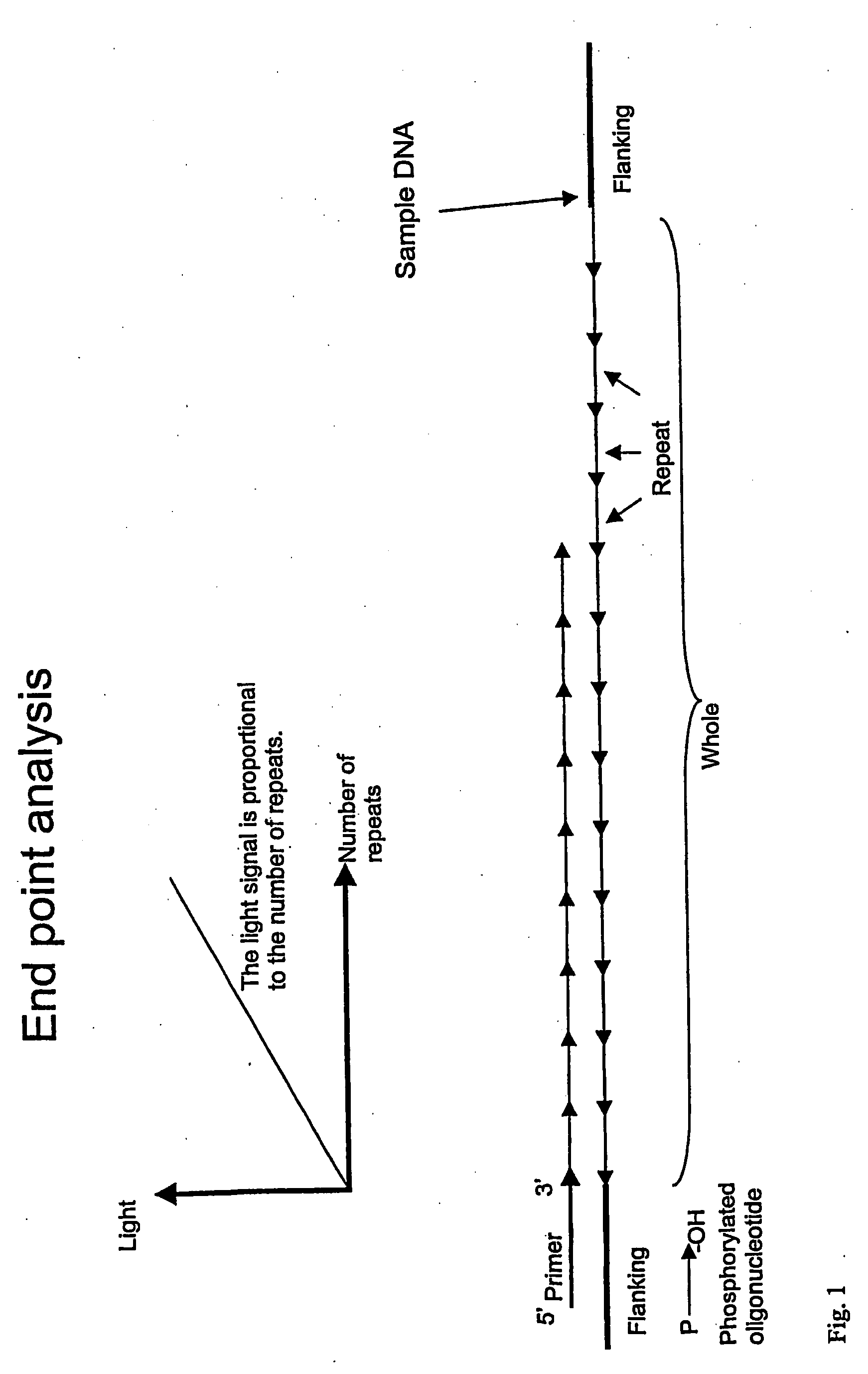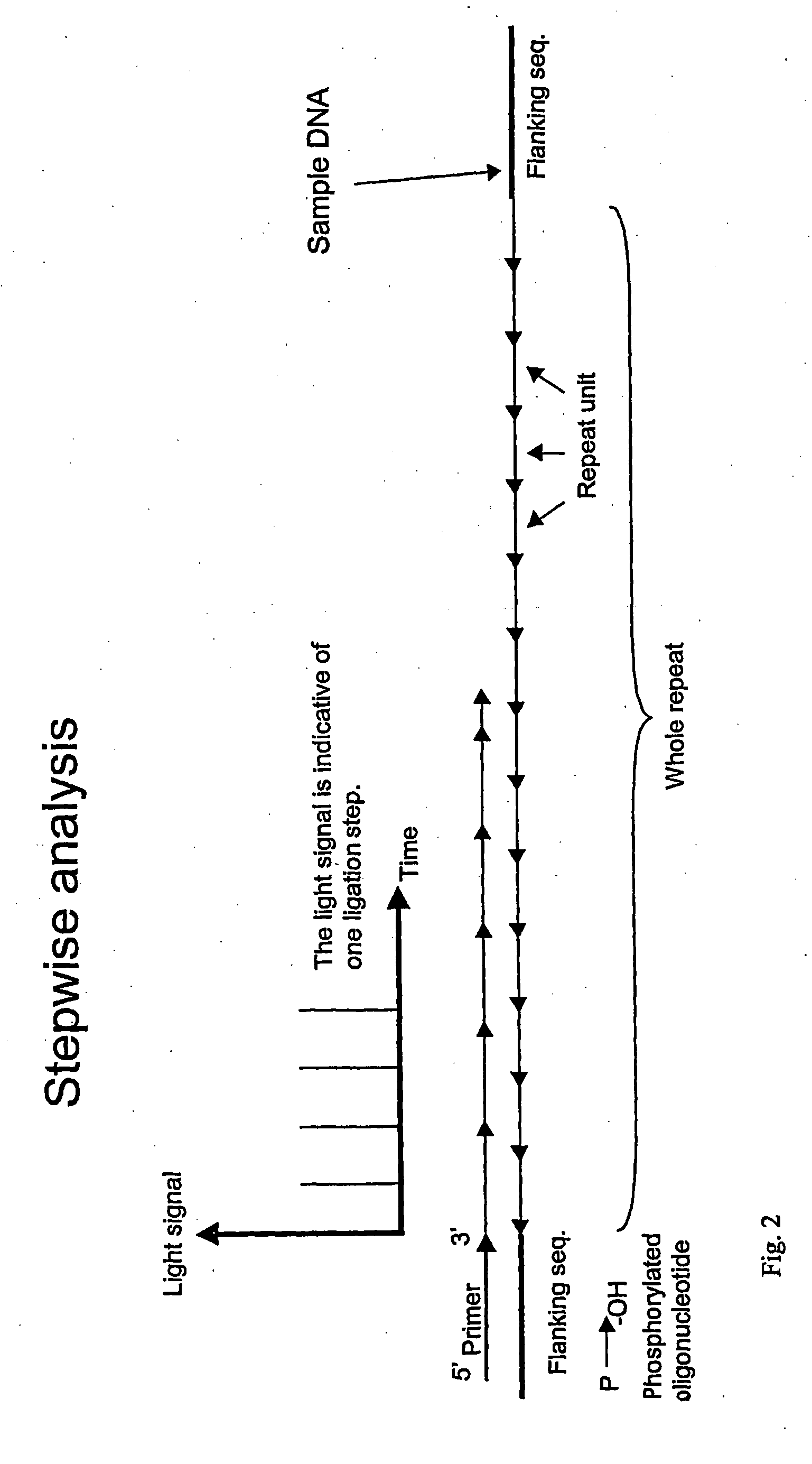Oligonucleotide Ligation Assay By Detecting Released Pyrophosphate
- Summary
- Abstract
- Description
- Claims
- Application Information
AI Technical Summary
Benefits of technology
Problems solved by technology
Method used
Image
Examples
example 1
Ligation of Two Oligonucleotides at a Variable Position in a Gene with a Thermocycled Ligation Reaction Followed by Bioluminescent Detection
[0146]
Oligonucleotides usedName5′-3′ModificationBGL-1ATGGTGCACCTGACTCCTGA5′ biotinBGL-2GGAGAAGTCTGCCGTTACTGC5′ PBG-TGCAGTAACGGCAGACTTCTCCTCAGGAGTCAGGTGCACCATComplete upper strandATGGTGCACCTGACTCCTGAGGAGAAGTCTGCCGTTACTGCBG-S1ACGGCAGACTTCTCC
[0147] The oligonucleotides were designed to represent a synthetic version of the region of the beta-globin gene containing a point mutation causing sickle-cell anaemia (see Barany, F. (1991) Genetic disease detection and DNA amplification using cloned thermostable ligase. Proc. Natl. Acad. Sci. USA 88, 189-193).
[0148] The oligonucleotides form the following complex after annealing:
BGL-2 BGL-1----------------------------A==========================-Biotin----------------------------T-------------------------- BGL-T
[0149] The following were mixed in a final volume o...
example 2
Ligation of Two Oligonucleotides at a Variable Position in a Gene with the Ligation Reaction Linked to Bioluminescent Detection. Combination of Ligase and PPDK Steps on Pre-Annealed Primer / Template Complex
[0153] The following were mixed in triplicate wells in a final volume of 20 μL in a 200 μL PCR tube: 20 mM Tris-acetate buffer, pH 7.6; 10 mM magnesium acetate; 5 pmole of template BGL-T; 20 pmol of each of the oligonucleotides BGL-1 and BGL-2. The oligonucleotides were annealed to the template by incubating at 80° C. for 5 minutes followed by cooling to room temperature. The annealed reaction was transferred to a microtitre plate used in PSQ96. Controls received only buffer. Twenty microlitres of a mix containing reagents for ligation and conversion of released AMP to ATP were then added. This mix contained the following: 20 mM Tris-acetate buffer, pH 7.6; 10 mM magnesium acetate; 2.5 mM NAD+; 25 mM DTT; 0.625 mM phosphoenolpyruvate; 0.375 mM sodium pyrophosphate; 50 μg PPDK; 20 ...
example 3
Detection of Difference in Number of CTG Repeats
[0154] The experiment was based on the trinucleotide repeat (CAG / CTG) that is involved in a number of polyglutamine diseases (see table above). One picomole of oligonucleotide template with the sequence (CTG)20 or (CTG)10 was mixed with 40 picomoles of the complementary 5′-phosphorylated oligonucleotide, (CAG)3 in 20 μL of Annealing Buffer (20 mM Tris-acetate, pH 7.6; 10 mM magnesium acetate; 20 mM potassium acetate) in a 96-well PSQ96 Plate. The short, phosphorylated oligonucleotide was annealed to the longer oligonucleotide templates by incubating for 5 minutes at 80° C. and then allowing to cool to room temperature. Ligation was performed by adding 5 μL of Ligation Mix (20 U Taq DNA ligase, 6.25 mM NAD+, and 62.5 mM dithithreitol in Annealing Buffer) and incubating for 30 minutes at 45° C. Controls with Ligation Mix without ligase were also run. The AMP released by the ligation reaction was converted to ATP by adding 15 μL of PPDK ...
PUM
| Property | Measurement | Unit |
|---|---|---|
| Electrical conductance | aaaaa | aaaaa |
| Electrical conductance | aaaaa | aaaaa |
| Light | aaaaa | aaaaa |
Abstract
Description
Claims
Application Information
 Login to View More
Login to View More - R&D
- Intellectual Property
- Life Sciences
- Materials
- Tech Scout
- Unparalleled Data Quality
- Higher Quality Content
- 60% Fewer Hallucinations
Browse by: Latest US Patents, China's latest patents, Technical Efficacy Thesaurus, Application Domain, Technology Topic, Popular Technical Reports.
© 2025 PatSnap. All rights reserved.Legal|Privacy policy|Modern Slavery Act Transparency Statement|Sitemap|About US| Contact US: help@patsnap.com



